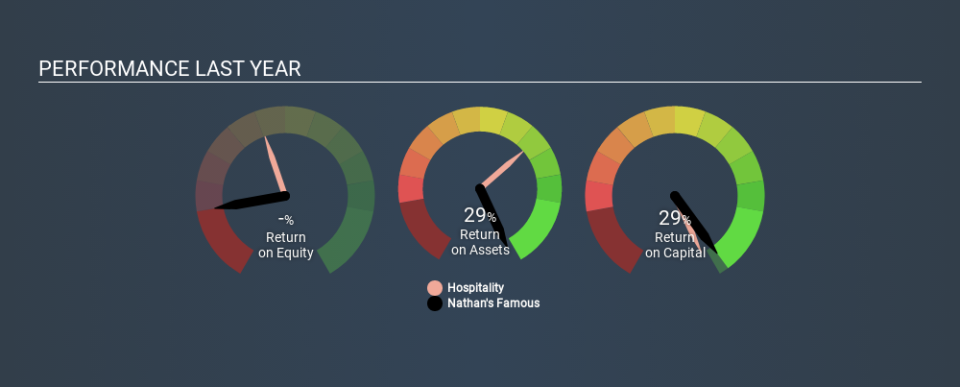Are Nathan's Famous, Inc.’s (NASDAQ:NATH) High Returns Really That Great?

Today we'll look at Nathan's Famous, Inc. (NASDAQ:NATH) and reflect on its potential as an investment. To be precise, we'll consider its Return On Capital Employed (ROCE), as that will inform our view of the quality of the business.
First, we'll go over how we calculate ROCE. Next, we'll compare it to others in its industry. Then we'll determine how its current liabilities are affecting its ROCE.
What is Return On Capital Employed (ROCE)?
ROCE is a measure of a company's yearly pre-tax profit (its return), relative to the capital employed in the business. Generally speaking a higher ROCE is better. Overall, it is a valuable metric that has its flaws. Author Edwin Whiting says to be careful when comparing the ROCE of different businesses, since 'No two businesses are exactly alike.
So, How Do We Calculate ROCE?
Analysts use this formula to calculate return on capital employed:
Return on Capital Employed = Earnings Before Interest and Tax (EBIT) ÷ (Total Assets - Current Liabilities)
Or for Nathan's Famous:
0.29 = US$27m ÷ (US$107m - US$14m) (Based on the trailing twelve months to September 2019.)
So, Nathan's Famous has an ROCE of 29%.
See our latest analysis for Nathan's Famous
Is Nathan's Famous's ROCE Good?
ROCE is commonly used for comparing the performance of similar businesses. Using our data, we find that Nathan's Famous's ROCE is meaningfully better than the 8.5% average in the Hospitality industry. I think that's good to see, since it implies the company is better than other companies at making the most of its capital. Putting aside its position relative to its industry for now, in absolute terms, Nathan's Famous's ROCE is currently very good.
Nathan's Famous's current ROCE of 29% is lower than its ROCE in the past, which was 39%, 3 years ago. Therefore we wonder if the company is facing new headwinds. The image below shows how Nathan's Famous's ROCE compares to its industry, and you can click it to see more detail on its past growth.
When considering ROCE, bear in mind that it reflects the past and does not necessarily predict the future. Companies in cyclical industries can be difficult to understand using ROCE, as returns typically look high during boom times, and low during busts. This is because ROCE only looks at one year, instead of considering returns across a whole cycle. You can check if Nathan's Famous has cyclical profits by looking at this free graph of past earnings, revenue and cash flow.
Do Nathan's Famous's Current Liabilities Skew Its ROCE?
Short term (or current) liabilities, are things like supplier invoices, overdrafts, or tax bills that need to be paid within 12 months. The ROCE equation subtracts current liabilities from capital employed, so a company with a lot of current liabilities appears to have less capital employed, and a higher ROCE than otherwise. To check the impact of this, we calculate if a company has high current liabilities relative to its total assets.
Nathan's Famous has total liabilities of US$14m and total assets of US$107m. Therefore its current liabilities are equivalent to approximately 13% of its total assets. A minimal amount of current liabilities limits the impact on ROCE.
What We Can Learn From Nathan's Famous's ROCE
Low current liabilities and high ROCE is a good combination, making Nathan's Famous look quite interesting. There might be better investments than Nathan's Famous out there, but you will have to work hard to find them . These promising businesses with rapidly growing earnings might be right up your alley.
I will like Nathan's Famous better if I see some big insider buys. While we wait, check out this free list of growing companies with considerable, recent, insider buying.
If you spot an error that warrants correction, please contact the editor at editorial-team@simplywallst.com. This article by Simply Wall St is general in nature. It does not constitute a recommendation to buy or sell any stock, and does not take account of your objectives, or your financial situation. Simply Wall St has no position in the stocks mentioned.
We aim to bring you long-term focused research analysis driven by fundamental data. Note that our analysis may not factor in the latest price-sensitive company announcements or qualitative material. Thank you for reading.


